Saireyaka – Barleria prionitis: Uses, Research, Remedies, Side Effects
Saireyaka- Barleria prionitis is a plant mentioned in Ayurveda for the treatment of skin diseases, burning urination, fever, localized swelling, goiter, dental caries and act like blood purifier.
Latin name- Barleria prionitis Linn.
Family- Acanthaceae (vasa kula)
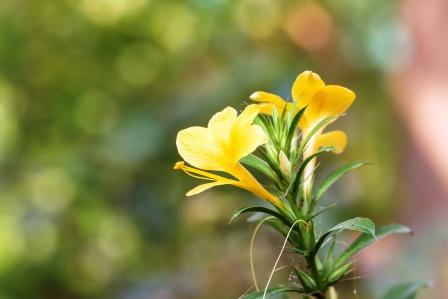
Table of Contents
Vernacular names
Names in different languages:
Hindi name – Katsareya
English name – Yellow nail-dye plant, Hop headed barleria
Kannada name – Gorantige
Bengali name – Kantajati, Jhanti
Gujarathi name – Kantasairiyo
Malayalam name – Chemmulli
Marathi name – Kalsunda
Tamil name – Shemmuli
Telugu name – Mullu goranti
Sinhalese name – Kattukurandu
Tulu name- Gorantedai
Sanskrit synonyms
Amlatan – A plant having flowers which will not fade.
Dasi – To cure diseases, this plant is being cut by physician
Bhana – The plant having thorns which are as sharp as an arrow.
Kurantaka – It is cut by the people to cure many diseases.
Saireyaka – The plant which grows in sunlight or in an open place.
Sahachar – The shrubs grow together in a group.
Mrudu Kantaka – having soft thorns
Varnadya – flowers are colorful
Kinkirantaka
Jhinti – the fruits make peculiar sound
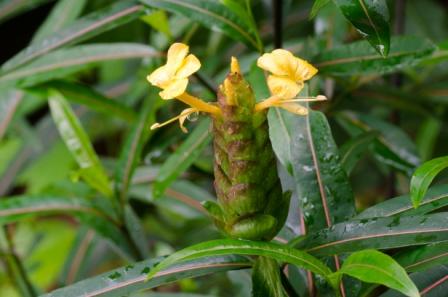
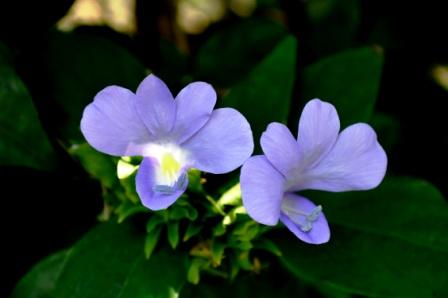
Varieties
Varieties based on colour: Bh.P . Ni & Ra . Ni
Pita Saireyaka – Barleria Prionitis Linn- Yellow
Sveta Saireyaka – Barleria Cristata Linn – White
Raktha Saireyaka – Barleria Cristata Linn – Red
Nila Saireyaka – Barleria Strigosa Willd – Blue
Ka. Ni – 3 varieties – Rakta, Pita and Nila
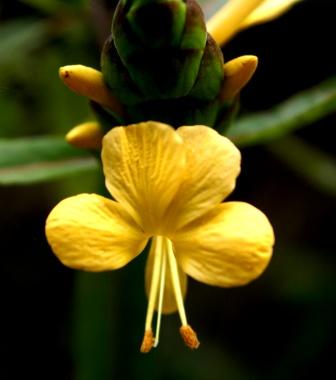
Morphology
Morphology of Barleria prionitis:
Saireyaka is a small shrub growing to a height of 1-1.5 m in height and is found in the temperate climate throughout India and is grown in the garden for its flowers. The plant has small, sharp spikes. The flowers are yellow and are found in clusters. Single seed is found in the small fruits.
The color of the flower may be white, yellow, red or blue depending upon the subspecies of the plant.
Useful part – Whole plant
Properties, part used, dosage
Properties:
Rasa (Taste) – Tikta (Bitter), Madhura (Sweet)
Guna (Qualities) – Laghu (Light for digestion)
Veerya (Potency) – Ushna (Hot)
Vipaka – Katu (Undergoes Pungent taste after digestion)
Karma (Actions) – Kaphavata shamaka (reduces vitiated kapha and vata dosha)
Part used- Whole plant especially leaf
Dosage-
Fresh juice- 10 to 20 ml
Decoction- 50 to 75 ml
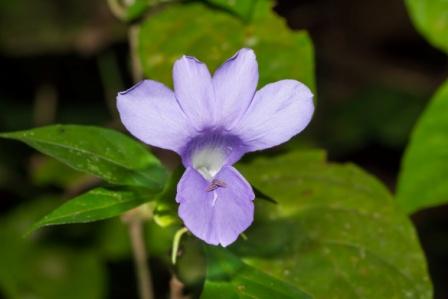
Chemical constituents
Chemical constituents of Barleria prionitis:
The plant is reported to be rich in potassium. With the exception of the large amount of a neutral and acid resin soluble in light petroleum ether, nothing of special interest was detected; there was no trace of any alkaloidal principle. Scutellar -7- rhamnosyl glucoside was isolated from flowers. Structures of iridoids-barlerin and acetyl barlerin were isolated from leaves and stems.
Uses
Uses of Saireyaka:
- The paste of the leaf is applied along with yogurt over the scalp to strengthen the hair and help in the growth of hairs.
- The paste of the leaf of Barleria prionitis is applied over the area affected with localized swelling.
- The decoction of the plant or leaf is given in a dose of 50 ml to treat difficulty and burning urination.
- The paste of the root of Barleria prionitis is applied over the throat to treat goiter.
- The paste of the leaf is applied over the tooth affected with dental caries to relieve pain.
- Sesame oil is processed with the leaf of Saireyaka and oil is prepared which is applied over the scalp to treat alopecia.
- The paste of the leaf is applied over the area affected with skin diseases like scabies and ringworm.
- The cold infusion of the plant of Saireyaka is given in a dose of 50 ml as blood purifier.
- The cold infusion is also given to treat fever associated with burning sensation.
- In children, the juice of the leaf of Barleria prionitis is given with honey in a dose of 20-25 ml to treat rhinitis and cough.
- The decoction of the plant or leaf is given in a dose of 50 ml to treat gout and cases of poison.
- The flower of the plant is used for decorative purposes at home.
The drug saireyaka is recommended in coryza, cough (caused by kapha) and especially in children cough and whooping cough. The leaves are cooked in oil which is applied on ulcers and wounds. Externally the leaves are applied on scabies, itching, dermatosis and other skin diseases.
The leaves juice of sveta saireyaka mixed with jeeraka is used in spermatorrhoea. Roots are taken in dysuria. Saireyaka is useful in oedema, blood impurities, vataraktha, upadamsha, nervine debility, poisons and skin diseases. In vatakaphaja jvara, the leaves juice is given.
The root of saireyaka and jivanthi pounded with goat’s milk and mixed with ghee is prescribed to be applied as paste in vataraktha. (A.H.ci 7/33)
In rat poisoning the root of saireyaka mixed with honey is suggested for oral use. ( A.H,uttara,38/30)
For treatment of cyst in blood vessels ( sira grandhi ) the oil of saireyaka is recommended in the acute stage ( A.S, uttara, 35/13).
The root of saireyaka rubbed with water is suggested for use by pregnant mother in order to develop fetus perfectly ( Gadanigraha, 24/5-6 )
The juice of bana leaves and lakucha mixed with oils is applied locally for eradicating kushta ( Vrudha madhava, 11/38 )
The juice of the leaves is slightly bitter and acid. It is generally administered in a little honey or sugar in catarrhal affections of children which are accompanied by fever and much phlegm.
A paste of the root is applied to boils and glandular swellings.
Erysipelas : In erysipelas caused by kapha, the paste of khadira, saptaparna, musta, aragvadha, dhava, kurantaka and devadaru should be applied. ( C.S, ci, 21/88 )
Calculas : Saireyaka is one of the ingredients of kusadya ghrta ( A.H.ci, 11/23 )
Eye diseases : In pterygium, after operation, the eye should be sprinkled with haridra, daruharidra, lodhra, pattola, madhuyasti, palasa and flower buds of saireyaka mixed with honey ( A.H. v, 11/22)
Graying of hairs : Oil 160 ml should be cooked with 640 ml of milk and juice of saireyaka, bhrangaraja and tulasi along with paste of madhu yastimadhu 40 gm and then kept in a strong
container or sheep horn ( A.H.u. 24/37-38 )
Sanskrit verse
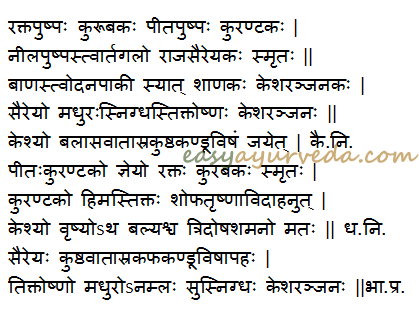
Indications
Uses as per Ayurveda:
Kesharanjana – used in colouring hair
Keshya – Improves hair strength, promotes hair growth
Vrushya – aphrodisiac, improves vigor
Balya – improves strength and immunity
Indicated in –
Vatasra – Gout
Kushta – skin diseases
Kandu – itching, pruritus
Visha – Toxic conditions, poisoning
Adverse effects
Adverse effect of Saireyaka: No adverse effect is seen after the normal use of Saireyaka.
Interaction with medicines, supplements
Can this be used while taking Homeopathic medicine?
Yes. This product does not react with homeopathic medicine.
Can this medicine be continued while taking supplements like multivitamin tablets, Omega 3 fatty acids etc?
Yes. Generally, this product goes well with most dietary supplements. However, if you are taking more than one product per day, please consult your doctor for an opinion.
With western
medicines
Seek your
doctor’s advice if you are taking this product along with other western
(allopathic / modern) medicines. Some Ayurvedic herbs can interact with modern
medicine.
If both Ayurvedic and allopathic medicines are advised together, then it is
best to take Allopathic medicine first, wait for 30 minutes and then take the
Ayurvedic medicine.
Ayurvedic medicines
Ayurvedic medicines containing Saireyaka:
Rasnadi ghrita: Rasnadi ghritam is a herbal medicated ghee formulation used for the treatment of rheumatoid arthritis and Vata related disorders associated with pain.
Rasnadi kashaya: This is a formulation in decoction form and is useful to treat arthritis, pain and other vata disorders.
Saptasaram kashaya: This is a decoction useful to treat hip pain, lower back pain, constipation, low digestion power, and menstrual pain.
Vathapy capsule: It is a proprietary ayurvedic medicine in capsule form and is useful to treat paralysis, Tones up nerves, muscles, brain and liver by improving the blood circulation.
Geecare: It is a proprietary Ayurvedic medicine in treating dental caries, gingivitis and maintaining oral care.
Research
Research articles related to Barleria prionitis:
Anti- diabetic activity: Alcoholic extract of leaf and root of B. prionitis was tested for their anti-diabetic activity. Animals treated with the alcoholic extract of leaves of B. prionitis Linn showed a significant decrease in blood glucose level (P<0.01) and glycosylated hemoglobin (P<0.01). A significant increase was observed in serum insulin level (P<0.01) and liver glycogen level (P<0.05), whereas the decrease in the body weight was arrested by administration of leaf extract to the animals. The alcoholic extract of roots showed a moderate but non-significant anti-diabetic activity in experimental animals.
Anti- arthritic activity: The present investigation was designed to evaluate anti-arthritic potential of ethyl acetate fractions of chloroform extract from leaves of Barleria prionitis. Dose dependent and significant inhibition of oedema was observed in both acute as well as chronic models. The extract at dose 250 mg/kg showed most potent and significant (P ⩽ 0.05–0.01) paw oedema inhibition which is supported by the results of body weight, biochemical parameters, motor incoordination and nociceptive threshold in Freund’s Complete Adjuvant-induced arthritis model.
Anti- oxidant potential: The aim of the present work was to investigate the antioxidant potential of different extracts of Barleria prionitis leaf and stem. The antioxidant capacity of methanolic extract of both the part, i.e. leaf and stem were found highest as IC50 values were 63.41±0.32, 81.69±0.40 respectively. The reducing power was also highest in the methanol extract of both parts.
Classical categorization
Bhavaprakasha- Pushpa varga – flower bearing group of plants
Dhanvantari Nighantu- Guduchyadi varga
Kaiyyadeva Nighantu- Oushadhi varga
Raja Nigantu- Karaveeradi varga
Scientific classification
Kingdom: Plantae
Order: Lamiales
Family: Acanthaceae
Genus: Barleria
Species: B. prionitis
Author:
Dr.B.K.Prashanth M.D (Ayu), Ph.D
E mail: [email protected]
Sthanika Karma (Systemic Action)
External – Relieve pain and edema. promote wound healing , good for hair. External application of its leaf paste is indicated in skin disorders, lymphadenitis, abscess etc. Leaf juice can be applied on tooth to prevent teethache. Oil prepared out its leaves is indicated for premature graying hair.
Nervous System – Strengthen the nervous.
Circulatory System – Indicated in vatarakta, Upadamsa, whole body edema etc.
Respiratory system – Indicated in running nose, kaphaja kasa, especially for children.
Reproductive system – Sukrasodhaka (Purifies semen) – Leaf juice of white variety of plant along with cumin seed powder is indicated in Sukrameha.
Satmikarana – Anti poisonous
Excretory system – Root is indicated in painful micturition
Skin – Indicated in various r skin disorders
Tapakrama – Leaf juice is beneficial in Fever (Vata kapha jvara)










